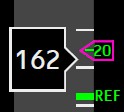 Sometimes during a NNM in the simulator you see that when landing configuration is established, and the aircraft is being manoeuvred around the approach at the minimum flap manoeuvre speed – a further speed reduction will be required to set the NNM checklist specified reference speed (plus 5 knots). Exactly when to set this speed often becomes a discussion point in the debrief …
Sometimes during a NNM in the simulator you see that when landing configuration is established, and the aircraft is being manoeuvred around the approach at the minimum flap manoeuvre speed – a further speed reduction will be required to set the NNM checklist specified reference speed (plus 5 knots). Exactly when to set this speed often becomes a discussion point in the debrief …
The most common error is to forget to reduce the speed and fly the approach and landing at the minimum flap speed, rather than reduce it to final approach speed for final approach and landing. This results in a slightly longer landing distance.
The next most common error is to reduce speed too early – the aircraft is left manoeuvring (turning, levelling) at several knots below minimum flap speed.
The correct technique is to set final approach speed – when on final approach. That is, when established on final descent straight in to the runway.
Practices & Techniques : 5.39 Setting Final Approach Speed … On Final.
Occasionally NNM events that require a non-standard final approach speed create a gap between the PFD placard minimum speed for the existing flap configuration and the required final approach reference speed – despite in landing flap configuration.
Specifically – while planning to land at Flap 20 because of a NNM, the manoeuvring component of the approach (vectoring, outbound, turning inbound, etc) is completed while maintaining the Flap 20 minimum speed.
However final approach and landing will be flown at the NNM checklist specified reference speed (+5 knots) which is often based on Vref 30 (plus additive) and can be several knots below the Flap 20 minimum speed. If this is the case – then the time to set the speed to the final approach reference speed is … when on final approach with, descent established towards the runway. Intermediate manoeuvring should be accomplished at the minimum flap speed – in other words don’t reduce speed too early (and don’t forget to reduce it …)
